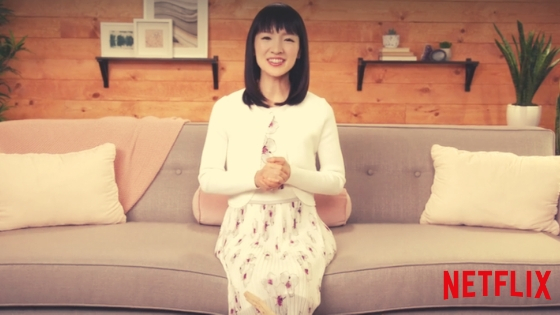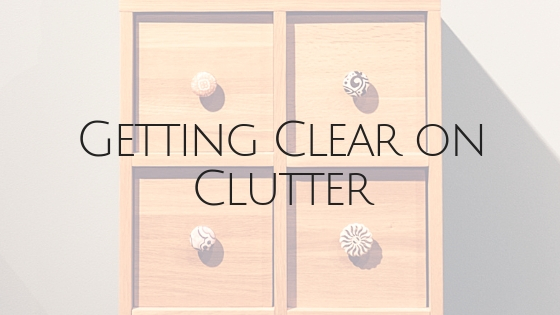Marie Kondo had Netflix viewers wrapped around her little finger from the first episode of Tidying Up. I’ll admit, I was one of the thousands of people that jumped up and squealed when I saw that Marie Kondo launched an original 8-part series on Netflix. Perfectly timed for all of us after-Christmas cleaner-uppers, the series aired on January 1st. My Christmas decorations were still up, and I was in the process of downsizing items in our family cottage with my husband and his family.
I didn’t try to get everyone on board to hold things in their hands and see if items sparked joy (Kondo’s method to decide whether to keep each and every thing you own). And I certainly didn’t hear anyone say “thank you” as they placed an item into a donation box, but I will say that her methods are worth striving for as we continue on our decluttering journey. However, depending on your lifestyle or culture, this method can also have flaws. I’m breaking down my thoughts on her first Netflix series (I have also ready most of her book, The Life-Changing Magic of Tidying Up) for you and your family.
 Reasons why I think the KonMari method is worth trying out with your family:
Reasons why I think the KonMari method is worth trying out with your family:
1.Gratitude – When you are blessed enough to have every room in your home chalk full of items, it’s not top-of-mind to say thank you to an item like a toothbrush or a pencil on the daily. However, Marie Kondo’s tidying up process is more of a lifestyle change than anything, making you acutely aware of what surrounds you and just how grateful you should be for your things. This is a life skill to teach your children at a young age. The more gratitude they have, the richer their lives will be.
2.Order – tell me if this has ever happened to you. You swore you bought a certain thing and when it comes time to use it, you have no idea where you put it in your home, so you either go without or purchase another SAME item. It hasn’t happened many times to my family but when it has, I have been furious with myself. Having a designated place (that makes sense) for everything helps your family know where to find what they are looking for.
3.Wealth – The less you have, the more you should save. This isn’t always the case. I remember my dad would always joke with me when I was growing up and I wanted to buy another pair of shoes or another bag. He would say, “Do you need it?” It used to drive me nuts, but he was right. And as a woman who previously loved shoes and bags, I now love the simplicity of having very few of both (and so does my wallet). Wealth is having what you need, and recognizing that as such.
4.Relief – One person I have followed for a very long time, organizer Peter Walsh, has always said “you use 80% of your clothes 20% of the time”. That is crazy but so, so true. I can tell you from experience, I tend to pick the first items I see in my closet or drawers. Everything else is simply taking up real estate. I know if I opened my drawer and found only what I wore, I would have more relief and less guilt having more than I need. In and around my home, having less to look at is also a relief.
5.Time – If you don’t have piles to get through before you find one document, you save time. If you have to find your keys and they have a place where they live, you will find them there, period. If you need to pick out an outfit and have limited choices, it will take less time.
6.Honour and Respect – While we have been clearing our family home of generations of items, we are taking stock of what is important to us. It will require time and effort, but it will be worth cherishing items that “spark joy” when we see them in a place of honour in our home.
You may have heard someone say, “you can’t take anything with you when you die”. What a morbid thought. The first thing that came to mind when I heard this was a scene in one of my all-time favourite children’s movies, The Labyrinth. As the main character wakes after being poisoned, she is faced with a junk lady that shows the girl her bedroom, reminding her of her toys and treasures. She tries to make the girl forget her quest for her brother, saying, “Everything you’ve ever cared for is right here”. But as she begins to remember what she was doing from reading her book, she has a revelation:
She remembers she is trying to find her brother and deems all her treasures junk because her brother is more important than her stuff. Does the main character live a minimalist lifestyle at the end of the movie? No, of course not. But the message is clear, people are more important than things.
The bottom line is that things really are just things. And the memories we have when we look a them will remain, even if we were to remove the items. I know better than anyone how easy that sounds and how brutally difficult it is to put into practice.
After my parents passed away, it’s as if time stood still with their treasures. I couldn’t get rid of anything that meant something to them. How could I? It was important to them, they had worked hard to afford it, or they placed a sentimental meaning to it since it was a gift from someone special.
There have been many times I wished I had my parents beside me to tell me “you know what, I never really loved that vase.” Or “every time I see that book, I remember your crazy aunt and how she upset me.”, but I don’t have them here to make these decisions. I have to make them myself and ultimately for myself.
Reasons it is difficult to follow the KonMari method:
1.Lifestyle – My father was a very visual person. He needed to see his stuff out in order to feel organized. I’m very much the same way. This means, laying out papers on my office floor and seeing what I have before me. Another person would loose their mind with this method. If you are a visual person, this method will be hard.
2.Little ones – good on Marie Kondo for helping her toddlers learn to origami their clothes and put them away. I am STILL getting my boys to learn to put things away and keep them in order. And yes, I have tried the KonMari method with them. The moment they pull something out to wear, disaster strikes. So with little ones, I think this would be very hard to keep up, mainly for clothes.
3.Space – In the Netflix series, there were some families that didn’t have great storage space (i.e. drawers, closets, etc.). If the intention to store things away and keep your counters and areas free of clutter, a proper storage unit is needed. So, if you are living in a small space with others, or do not have closed cupboards and drawers, it will be difficult.
4.Support –Changing the way your buy, the way you organize and the way you essentially live means getting the whole of your household on the same page. If you don’t have everyone on board in your household for this lifestyle change, good luck, mama. You wouldn’t want to implement all this change only to have it scoffed at.
I looked to my friend, and professional organizer, to truly explain why the method could run into problems. Here is what Liz Cohene of ProjectOrganize.ca had to say:
“I think it’s awesome that the profession of organizing is getting this attention, but the important thing to remember is that it’s very personal, definitely not one size fits all. What works for one family may not work for another. Marie has amazing strategies and underlying her premise is great, but what makes a system successful is that it is adapted to each individual or family. Every individual/family has their own groove, their own routines, and their own standards of tidiness, clutter and organization. A trained professional organizer will customize a system to work specifically for their needs and wants, giving them the best possible outcome.”
There you have it. I can’t tell you how important it is to find an organizer that can help you in your biggest projects. Liz is my best friend and it would have been so easy for her to call me out on my stuff, since she has known me almost my whole life. But her method and her professionalism helped me feel so comfortable and determined to keep going. I’ll leave you with this one last thought.
Shifting Your Idea of Stuff
Something monumental happened while we were emptying out our family cottage. There was an item that no one really had any affection toward. It was nice but unnecessary. My brother in law asked (as we had also for other items) “did this belong to someone important in our family?”. And then it hit me like a ton of bricks. We were looking for a reason to hold on to something if there was a story attached to it, even if we didn’t love it. Of course, we want to know our family history and heirlooms that were passed down for generations before us. But this said item was a loner, a dud, a simple thing none of us cared about. What would it matter, then, if there was someone else’s story placed on it? It can be real tricky but it’s a great moment of reflection to take on each item.
So? Have you tried the KonMari method? If you haven’t, will you?

